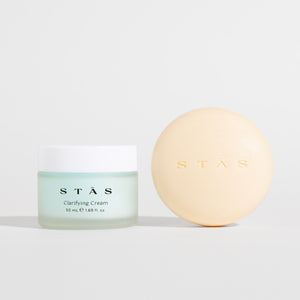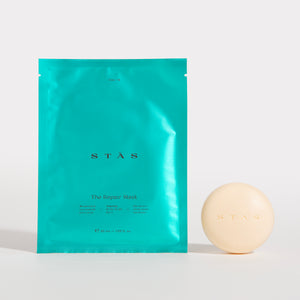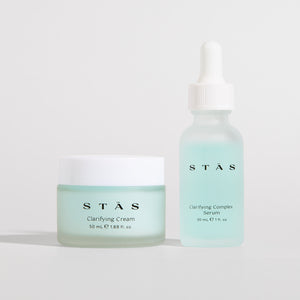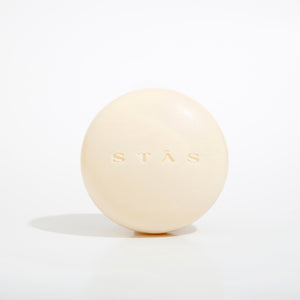What is a Water Cream, and Why Your Summer Skin Loves It
Aug 14, 2025
Water Creams Are Everywhere. We've Been Making One Since 2016.
Everyone's talking about water creams like they just discovered hydration. They're all over TikTok, beauty magazines, influencer feeds. But STĀS has been making one since 2016, not because it was trendy, but because people with reactive skin were literally avoiding moisturizer rather than risk another product that might wreck their complexion.
The real backstory
STĀS founder Stacy Wu was working as an esthetician when she kept seeing the same pattern. Clients with oily, sensitive skin telling her they couldn't find a moisturizer that didn't cause breakouts. The market was saturated with heavy creams and intensive repair formulas that were way too much for already-stressed skin.
So STĀS created what didn't exist: a moisturizer that actually understands reactive skin.
Why your skin might need a water cream
Here's what most people don't realize: oily skin and dehydrated skin aren't opposites. You can have skin that produces excess sebum by noon and still be desperately lacking water at the cellular level. Traditional moisturizers often miss this completely.
Heavy creams designed for dry skin can clog pores and trigger breakouts in oily skin types. But skipping moisturizer altogether signals your skin to produce even more oil to compensate for the lack of hydration. Water creams solve this by delivering moisture in a form that oily, acne-prone, or sensitive skin can actually handle.
The gel-like texture comes from a higher water content and specific humectants that pull moisture into the skin without creating a barrier that traps oil and bacteria. For people living in humid climates, dealing with hormonal fluctuations, or managing conditions like rosacea or eczema, this lighter approach often works better than traditional creams.
The science behind what actually works
Not all water creams are created equally. The texture might look similar, but the ingredient science varies dramatically between brands. STĀS built their Clarifying Cream around ingredients that address the root causes of skin reactivity, not just surface hydration.
Propanediol is a humectant that draws water into the skin from both the environment and deeper skin layers. Unlike some humectants that can feel sticky or heavy, propanediol creates a smooth, weightless feel while providing long-lasting hydration.
Glycerin works as a moisture magnet, but the key is using it at the right concentration. Too little and it's ineffective. Too much and it can feel tacky or attract so much moisture it actually pulls water out of your skin in dry environments.
Vitamin C derivative provides antioxidant protection and brightness support without the irritation potential of l-ascorbic acid. Many vitamin C forms are too harsh for sensitive skin, but the stable derivative used in STĀS formulations delivers benefits without triggering reactivity.
Glutathione is often called the "mother of all antioxidants" because it's naturally produced in your body and works at the cellular level to combat oxidative stress. In skincare, it supports clarity and brightness while helping skin defend against environmental damage.
Tea tree oil and witch hazel are included at precise concentrations that provide antimicrobial and astringent benefits without over-drying or irritating skin. This is where the collaboration between esthetician insight and formulation science matters.
Why the water cream trend exploded now
Water creams aren't actually new. Korean beauty brands have been perfecting lightweight, hydrating formulas for decades. But several factors made them mainstream in Western markets recently.
Climate change means more people are dealing with humid, unpredictable weather that makes heavy moisturizers feel unbearable. Urban pollution creates skin stress that requires gentle, protective hydration rather than intensive repair formulas. The rise of multi-step skincare routines means people want lighter, layerable products instead of one heavy cream doing everything.
Social media amplified the trend because water creams are visually satisfying. They look good in videos, the texture transformation is dramatic, and the immediate absorption creates that instant gratification that performs well on platforms like TikTok and Instagram.
But here's where STĀS differs from trend-driven launches: their Clarifying Cream was developed because clients needed it, not because water creams were having a moment. That practical, problem-solving approach shows in the formulation choices and ingredient concentrations.
How to actually use a water cream
Water creams work best when you understand where they fit in your routine. Apply them to clean, slightly damp skin for better absorption. If you're using other serums or treatments, water cream typically goes on last in your morning routine, or second-to-last if you're using sunscreen.
In humid weather or during summer months, a water cream might be all the moisture your skin needs. But in dry climates or winter conditions, you might need to layer it under a more occlusive moisturizer or facial oil.
For acne-prone skin, water creams work particularly well because they provide necessary hydration without interfering with other acne treatments. Many people using retinoids, salicylic acid, or benzoyl peroxide find that water creams deliver moisture without reducing the effectiveness of their active ingredients.
Solving specific skin scenarios
If your skin gets oily by midday but feels tight: You're likely dealing with dehydrated skin that's overproducing oil to compensate. A water cream provides the cellular hydration your skin needs without adding surface oils that contribute to shine.
If you live somewhere hot and humid: Heavy moisturizers can feel suffocating and may not absorb properly in high humidity. Water creams work with your environment instead of against it.
If you break out from most moisturizers: Look for water creams with minimal ingredients and avoid common irritants like synthetic fragrances, essential oils, or high concentrations of plant extracts. STĀS Clarifying Cream keeps the formula focused on hydration and clarity support without unnecessary additives.
If you have sensitive or reactive skin: Water creams typically contain fewer potential irritants than traditional moisturizers. The lightweight texture means less product sitting on your skin, which can reduce reaction potential.
If you're dealing with hormonal fluctuations: Whether it's monthly cycles, pregnancy, or other hormonal changes, your skin's oil production and sensitivity can fluctuate dramatically. Water creams adapt better to these changes than heavy formulas that might be too much during oily phases or not enough during dry phases.
The bottom line
Water creams work because they solve a real problem: how to hydrate skin that reacts poorly to traditional moisturizers. STĀS has been quietly perfecting this approach since 2016, using esthetician expertise and client feedback to create something that actually works for reactive skin.
The current trend means more options are available, which is great for consumers. But when choosing a water cream, look beyond the texture to the actual ingredient science. Your skin deserves hydration that supports its function rather than just following what's popular on social media.
For anyone who's been avoiding moisturizer or struggling to find something that hydrates without causing problems, STĀS Clarifying Cream represents eight years of refinement specifically for skin that needs a gentler approach to moisture.







